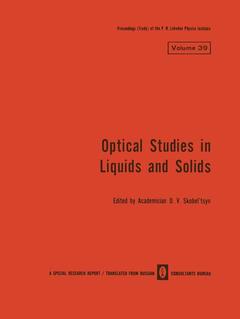Description
Optical Studies in Liquids and Solids, Softcover reprint of the original 1st ed. 1969
The Lebedev Physics Institute Series, Vol. 39
Language: English
Keywords
Vibration; chemical bond; collision; development; experiment; information; mechanical property; molecule; scattering; sorption; spectra; structure
Publication date: 01-2014
266 p. · 21x27.9 cm · Paperback
266 p. · 21x27.9 cm · Paperback
Description
/li>Contents
/li>
The study of the vibrations of polyatomic molecules has recently turned into one of the most widespread and powerful methods of studying molecular structure. These vibrations ap pear directly in the infrared absorption spectra and Raman spectra of gases, liquids, and solids. A measurement of the number of bands in addition to their positions (frequencies or wavelengths) offers the possibility of obtaining a great deal of important information regarding the geometric and mechanical properties of the molecules, the types of chemical bonds, and so forth. It is now quite difficult to list the vast number of specific problems solved by measuring vibrational fre quencies. As a result of the successful development of research methods and the widespread applica tion of vibrational spectra in analyzing the structures of molecules and the constitution of ma terials, it now becomes necessary to develop the theory of molecular vibrations further. Existing theory, of course, is based on the assumption of the harmonicity of molecular vi brations, which, strictly speaking, is not justified experimentally. The anharmonicity of the molecular vibrations has therefore to be taken into account by introducing appropriate approxi mations. Thus, in carrying out calculations on the vibrations of polyatomic molecules, one uses the force constants calculated from the observed frequency values. However, as a result of the anharmonicity of the vibrations, the values of the observed frequencies differ from the harmonic values, and the force constants used therefore differ from the true ones, i. e.
Study of Second-Order Lines in the Vibrational Spectra of Molecules.- I. Review of Literature and Presentation of the Problem.- II. Experimental Method.- III. Experimental Results.- IV. Discussion of Results and General Conclusions.- Study of the Rotational Oscillation of Molecules in Liquids by the Raman Method.- I. Review of Literature.- II. Methods of Obtaining and Analyzing Low-Frequency Raman Spectra.- III. Appearance of the Rotational Oscillations of Methyl Groups in Low-Frequency Raman Spectra.- IV. Appearance of the Rotational Oscillations of Ethyl and Heavier Groups in the Low-Frequency Raman Spectra.- Study of the Optical and Electrical Properties of Certain Fourth-Group Metals.- I. Theoretical Study of the Optical Properties of Metals.- II. Measuring Method.- III. Results of the Measurements.- IV. Analysis of Experimental Results.- Study of the Spectrum of the Thermal and Stimulated Molecular Scattering of Light in Liquids.- I. State of Theoretical and Experimental Knowledge Regarding the Spectral Composition of the Molecular Scattering of Light.- II. Theory of the Spectral Composition of the Depolarized Scattering of Light in Liquids.- III. Methods of Studying the Spectral Composition of Scattered Light.- IV. Results of an Experimental Study of the Spectrum of Depolarized Scattered Light in Low-Viscosity Liquids.- V. Determination of the Velocity and Absorption of Hypersound in Liquids from the Width of and Spacing Between the Mandelshtam-Brillouin Components.- VI. Stimulated Molecular Scattering of Light.- Gamma- and Photoluminescence of Alkali Iodides.- I. Presentation of the Problem.- II. Study of ?-Luminescence in Alkali Iodides.- III. Study of the Spectral Characteristics of the Photoexcitation of Phosphors Based on Alkali Iodides.- IV. ConcentrationDependence of the Time Characteristics of the Phosphors CsI-Tl and KI-Tl.- V. Discussion of Results.
© 2024 LAVOISIER S.A.S.




